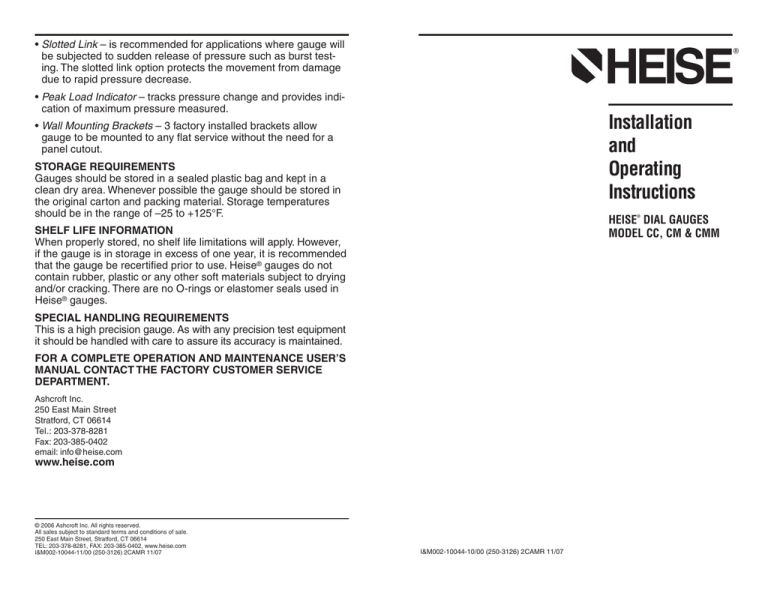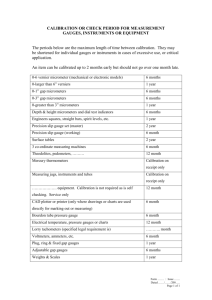
• Slotted Link – is recommended for applications where gauge will
be subjected to sudden release of pressure such as burst testing. The slotted link option protects the movement from damage
due to rapid pressure decrease.
• Peak Load Indicator – tracks pressure change and provides indication of maximum pressure measured.
Installation
and
Operating
Instructions
• Wall Mounting Brackets – 3 factory installed brackets allow
gauge to be mounted to any flat service without the need for a
panel cutout.
STORAGE REQUIREMENTS
Gauges should be stored in a sealed plastic bag and kept in a
clean dry area. Whenever possible the gauge should be stored in
the original carton and packing material. Storage temperatures
should be in the range of –25 to +125°F.
®
HEISE DIAL GAUGES
MODEL CC, CM & CMM
SHELF LIFE INFORMATION
When properly stored, no shelf life limitations will apply. However,
if the gauge is in storage in excess of one year, it is recommended
that the gauge be recertified prior to use. Heise® gauges do not
contain rubber, plastic or any other soft materials subject to drying
and/or cracking. There are no O-rings or elastomer seals used in
Heise® gauges.
SPECIAL HANDLING REQUIREMENTS
This is a high precision gauge. As with any precision test equipment
it should be handled with care to assure its accuracy is maintained.
FOR A COMPLETE OPERATION AND MAINTENANCE USER’S
MANUAL CONTACT THE FACTORY CUSTOMER SERVICE
DEPARTMENT.
Ashcroft Inc.
250 East Main Street
Stratford, CT 06614
Tel.: 203-378-8281
Fax: 203-385-0402
email: info@heise.com
www.heise.com
© 2006 Ashcroft Inc. All rights reserved.
All sales subject to standard terms and conditions of sale.
250 East Main Street, Stratford, CT 06614
TEL: 203-378-8281, FAX: 203-385-0402, www.heise.com
I&M002-10044-11/00 (250-3126) 2CAMR 11/07
I&M002-10044-10/00 (250-3126) 2CAMR 11/07
SAFETY PRECAUTIONS
Pressure gauge selection should be done in accordance with
recognized industry codes and safety practices to avoid the possibility of misuse or misapplication which could result in personal injury or damage to property. ASME B40.1 should be consulted by
those responsible for gauge selection and installation.
UNPACKING THE GAUGE
All Heise® gauges are shipped with a piece of foam between the
glass window and the pointer. This foam secures and protects the
movement from damage during shipment. THIS FOAM MUST BE
REMOVED PRIOR TO INSTALLATION AND OPERATION OF
THE GAUGE
To remove foam, first remove the zero adjust lock screw located
beneath the dial face. This is the screw located in the center of the
zero adjust knob. With this screw removed lift the bottom of the
bezel away from the gauge. Then lift the bezel up and off the alignment pin at the top of the gauge. With bezel assembly off, remove
pad. Reinstall bezel through reverse procedure. Be certain to align
the teeth for zero adjust mechanism prior to replacing dial adjust
lock screw.
GAUGE INSTALLATION
Unless otherwise specified at the time of order Heise® gauges are
calibrated in the upright or vertical position. Gauges should always
be mounted in the same position as they were calibrated to eliminate positional errors. Special calibration is required for gauges to
be mounted in any position other than vertical. All Heise® gauges
have three holes for 1⁄4˝ screws spaced 120° apart on the back of
the bezel to facilitate panel mounting. Factory installed wall mounting brackets are available as an option.
GAUGE OPERATION
Heise® gauges are precision instruments. Certain procedures and
precautions are recommended in order to maximize their performance. These are:
For liquid systems the trapped air should be purged from the system using the bleeder cap on the end of the Bourdon tube. When
opening or closing the bleeder cap firmly hold the free end of the
Bourdon tube to protect the movement, Bourdon tube or linkages
from damage due to stress. To bleed air from system open bleeder
cap slightly and carefully apply pressure to the gauge to force fluid
through the cap. Allow the fluid to flow for several seconds to
purge trapped gas from the tube. Direct the fluid away from the
gauge to protect the movement from becoming contaminated.
Once this is done tighten cap.
It is good practice to pressurize the gauge to full scale for several
minutes prior to use. The pressure should then be removed and
the dial zeroed, if necessary. The dial adjuster is located at the
bottom of the dial. The smaller central knob is an adjustment lock
and the larger, outer knob is used for zero adjustment.
PRESSURE MEDIA
Care should be taken to assure that the process pressure media
are compatible with the gauge wetted materials. Hydrogen use
should be limited to gauges equipped with Beryllium Copper
Bourdon tubes. Consult factory for questions regarding media
compatibility.
Unless specially cleaned, the gauge wetted surfaces may include
cleaning solvent or hydrocarbon (oil) residue from the manufacturing and calibration processes. These substances may be incompatible with specific installations or process media. Consult factory
for special factory cleaning options. DO NOT USE GAUGES ON
OXYGEN SERVICE UNLESS GAUGE HAS BEEN CLEANED
AND CERTIFIED FOR OXYGEN USE. Failure to comply with
these recommendations could result in damage to the gauge and
personal injury.
GAUGE ACCURACY & CALIBRATION
Heise‚ gauges are calibrated at the factory to ±0.1% F.S. accuracy
and certified, traceable to the N.I.S.T., USA. (Note: For gauges
equipped with 316 SS Bourdon tubes, hysteresis may exceed
0.1% and is not guaranteed). Primary calibration adjustments on
the movement are sealed with liquid metal and should not be altered. Tampering with these calibration points may degrade the accuracy of the gauge and will void the warranty.
Under normal operation, a one-year calibration cycle is recommended for your Heise gauge(s). Recertification services are
available at the factory.
OPTIONAL FEATURES
• Bimetallic Thermal Compensation – is recommended for all
gauges that are to be installed in non-temperature controlled environments. This option maintains the 0.1% of span accuracy
over a range of –25 to +125°F. Gauges not equipped with this option may incur an additional 0.1% error per 5°F deviation outside
the operating temperature window of 68-72°F.




